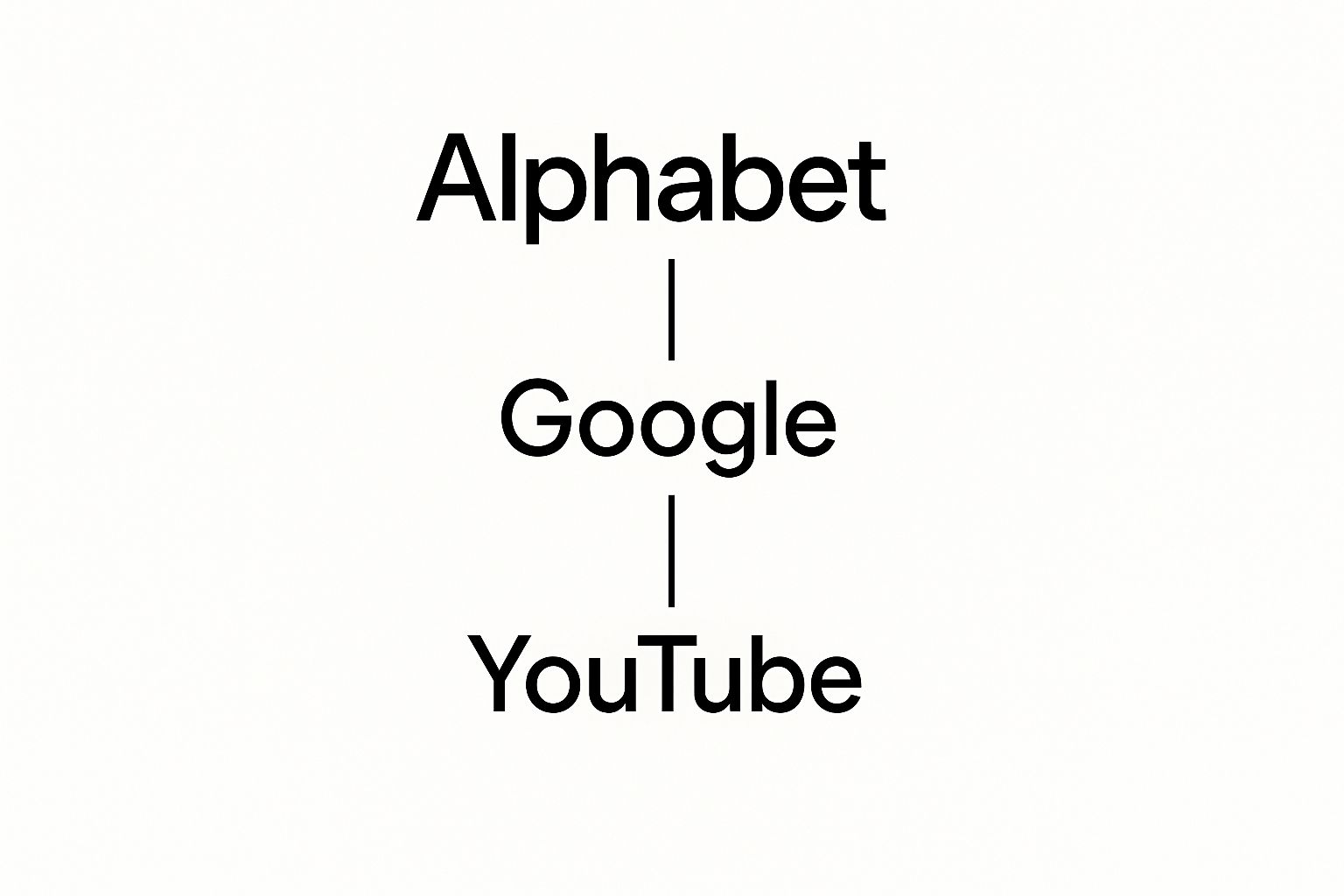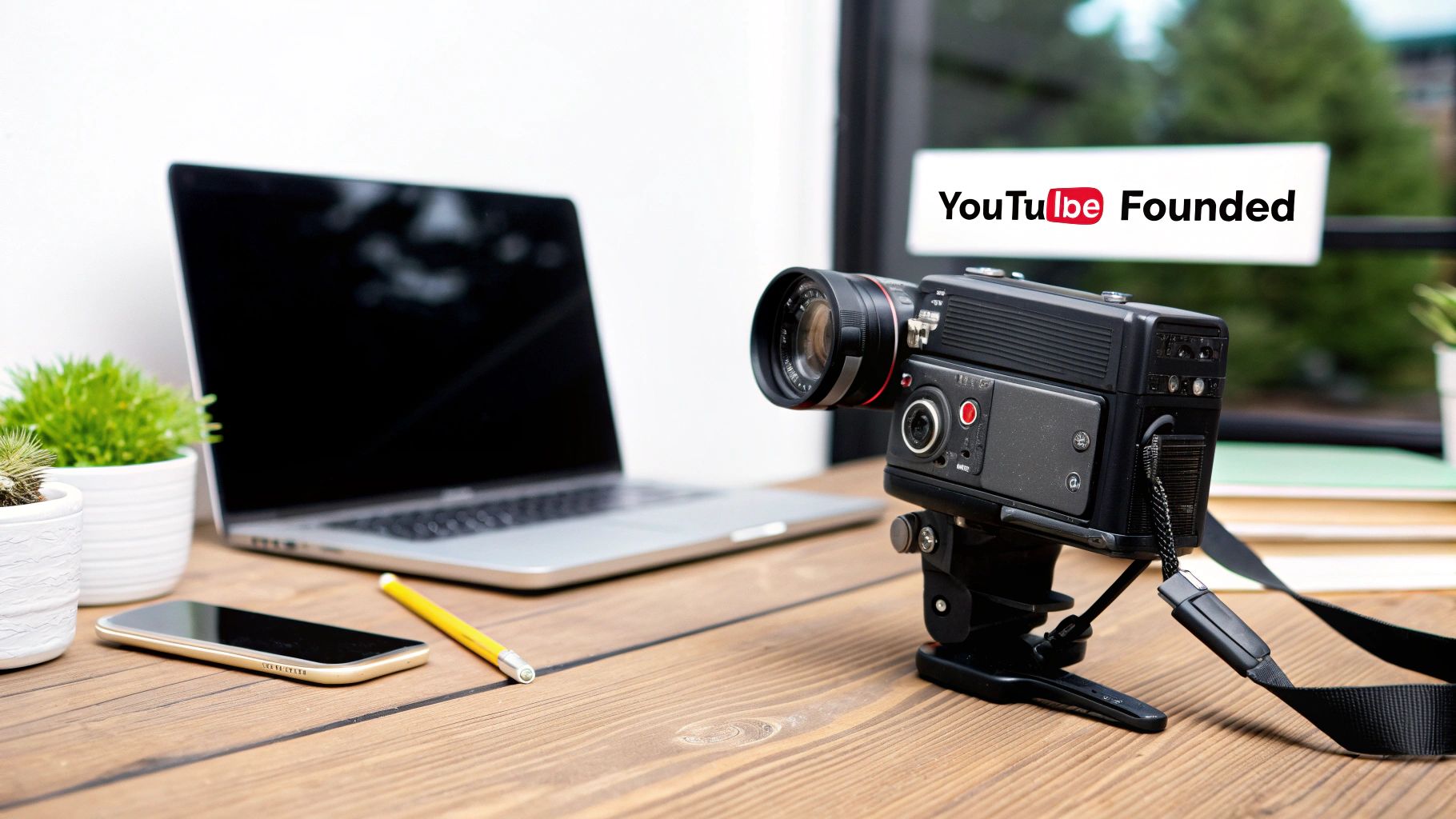So, who really owns YouTube? Let's get straight to the point, because understanding the answer is crucial for any creator, educator, or researcher building a presence on the platform.
The short answer is Google LLC. But that's not the whole story. Google itself is a subsidiary of a much larger tech giant, Alphabet Inc.
Think of it like a set of Russian nesting dolls. Alphabet is the biggest doll on the outside. Open it, and you'll find Google. Nestled inside Google? That's YouTube. This structure isn't just corporate trivia; it's the engine that powers the entire platform, influencing everything from the algorithm to the tools you use every day.
From Startup To Global Powerhouse
To really grasp why YouTube works the way it does, we have to look back at its journey. It all started in February 2005 with founders Steve Chen, Chad Hurley, and Jawed Karim. Their idea for a simple video-sharing platform took off like a rocket.
That explosive growth didn't go unnoticed. In November 2006, Google swooped in and bought the startup for a landmark $1.65 billion. At the time, it seemed like an astronomical sum, but it was a visionary move that would forever change the face of online video.
This handy diagram breaks down the corporate family tree, showing the clear chain of command from Alphabet all the way down to YouTube.

To give you a clearer picture of this evolution, here's a quick summary of the major milestones in YouTube's ownership history.
YouTube's Ownership Journey at a Glance
| Milestone | Date | Key Players | Significance |
|---|---|---|---|
| Founding | February 2005 | Steve Chen, Chad Hurley, Jawed Karim | A new platform for user-generated video is born, quickly gaining traction. |
| Google Acquisition | November 2006 | Google LLC | Google acquires YouTube for $1.65 billion, integrating it into its powerful ecosystem. |
| Alphabet Restructuring | August 2015 | Google, Alphabet Inc. | Google reorganizes, creating Alphabet Inc. as its parent company to manage diverse ventures. |
| Current Status | Present | Alphabet Inc., Google LLC | YouTube operates as a key subsidiary of Google, under the Alphabet umbrella. |
This timeline shows just how YouTube went from a disruptive startup to a core part of one of the world's most powerful tech companies.
So, what does this all mean for you as a creator? Being part of the Google family gives YouTube access to a staggering amount of resources—from world-class server infrastructure to a global advertising network. It's the bedrock that defines the tools you use, the policies you follow, and the ways you can earn a living. It even shapes which video ideas for YouTube are most likely to succeed. In this guide, we'll dig into how this ownership directly impacts your journey.
The Founders' Vision and the Billion-Dollar Bet
Before it became the titan of online video we know today, YouTube was a startup with a brilliantly simple idea. In early 2005, former PayPal employees Chad Hurley, Steve Chen, and Jawed Karim saw a glaring problem: sharing videos online was a mess. It was clunky, complicated, and frustrating for the average person. Their solution was a free, user-friendly platform where anyone could upload and share their videos with the world.
This bet on user-generated content was a game-changer. It directly challenged competitors like Google Video, which focused on licensing content from big media companies. The founders' vision connected with a new generation armed with affordable video cameras and basic editing software. The timing was perfect, and it led to explosive growth.
After launching its beta in May 2005, the site was already attracting 30,000 daily visitors. By its official launch that December, this number had skyrocketed to 2 million video views per day.
The Strategic Acquisition
Google didn't just see a competitor; it saw a phenomenon. It quickly became clear they weren't just losing the video war—they were losing to a platform with a different, and far more successful, DNA. So, instead of trying to beat YouTube, Google decided to buy it. In October 2006, Google announced it was acquiring YouTube for a jaw-dropping $1.65 billion in stock.
“The YouTube team has built an exciting and powerful media platform that complements Google’s mission to organize the world’s information and make it universally accessible and useful.”
– Eric Schmidt, former CEO of Google
This wasn't just about absorbing a popular website. Google saw the incredible potential in pairing its search and advertising machine with YouTube's massive, deeply engaged audience. It was a bet on the future of online advertising and the coming dominance of video content. This screenshot from Wikipedia gives a sense of the platform’s look back in that era.

That user-first design was a huge part of its initial magic. For creators, this history is vital because it forged the platform's core identity—a space for individual creativity, now supercharged by the immense corporate and technological engine of Google.
How the Google and Alphabet Structure Works
Most people know Google owns YouTube, but the name Alphabet can be confusing. It's actually simple: Alphabet is the giant parent company, and Google is its biggest and most famous brand.
The 2015 corporate restructuring that created Alphabet Inc. was a strategic move. It allowed specialized divisions like Search, Android, and, of course, YouTube, to operate with focus under the Google umbrella, which itself sits under the even larger Alphabet umbrella. This structure lets each part, like YouTube, run with significant freedom while still tapping into the mothership's resources.
Think of it like this: YouTube gets an all-access pass to Google's world-class data centers, its groundbreaking AI research, and the powerful advertising tech that fuels everything. These are the engines that keep your videos streaming and your AdSense payments flowing.
Why This Matters to Creators and Researchers
This corporate family tree isn't just trivia—it directly shapes the platform you rely on. When YouTube rolls out a new feature or policy, it’s not a decision made in a vacuum. It’s often tied to the larger goals of Alphabet, a tech behemoth focused on organizing information and pushing technology forward.
For creators and researchers, this has real-world consequences:
- Powerful Tech: Features you use daily, like the recommendation algorithm and Content ID, are supercharged by Google's massive investments in AI and machine learning.
- Global Reach: That smooth, instant playback for a viewer in Tokyo watching your video uploaded in Texas? That’s the power of Google's global server infrastructure at work.
- Future-Forward Tools: Alphabet’s big bets on AI and new advertising models directly influence the tools and monetization options that land in your Creator Studio.
Understanding this structure helps you see the bigger picture. Every detail, down to the optimal size for a YouTube thumbnail, is part of a platform built for immense scale, all thanks to its spot in the Google and Alphabet family.
How Google's Ownership Shapes Your Creator Journey
It’s easy to think of the Alphabet and Google structure as a distant boardroom affair, but its influence touches everything you do as a creator. This is where the answer to "who owns YouTube?" gets personal. From uploading a video to earning your first dollar, Google’s DNA is woven into the entire process.
Take monetization. The system is built on AdSense—Google's own advertising network. This direct pipeline means payment structures, ad formats, and policies are all dictated by Google's bigger business goals. When you receive a copyright claim, you’re interacting with Content ID, a massive system built on Google’s huge investment in AI.
Thriving in a Data-Driven Ecosystem
At its heart, Google is a data company. This identity means that to succeed on YouTube, you must think like Google. The platform isn't just a creative space; it’s an algorithm-driven world that rewards creators who pay attention to performance metrics and adapt their strategy. Guesswork and pure creative intuition are no longer enough to cut through the noise.
In a world governed by Google's algorithms, data isn't just helpful—it's your roadmap. Ignoring analytics is like trying to navigate a new city without a map; you might find your way, but you'll waste time and energy doing it.
Practical Tools for a Google-Powered World
To work with the platform, not against it, you need the right tools. For instance, you can’t make smart decisions without a clear picture of what’s happening on your channel. A dedicated YouTube Channel Analytics tool gives you the deep-dive data needed to see what’s working and what isn’t, helping you align your content with what the algorithm favors.
Similarly, in a sea of millions of videos, your thumbnail is your most important piece of advertising. It's the first impression you make. A professional YouTube Thumbnail Maker helps you design compelling, high-CTR visuals that are essential for grabbing clicks. For those needing more advanced features, the YouTube Thumbnail Studio offers layers and effects to create truly professional-grade designs.
Finally, while YouTube is an incredible launchpad, smart creators maintain control of their work. Many find it useful to have a personal archive. If you're looking for ways to do this, our guide on YouTube video downloaders offers tips on how to safely back up your videos.
The Power and Global Reach of Google's YouTube

To understand why Google's ownership is a big deal, you have to appreciate the platform's sheer size. YouTube is a global communication network with a massive footprint. That staggering advertising revenue is the engine that keeps the entire YouTube Partner Program humming, funding creator payouts worldwide.
This scale isn't just a number—it's a direct line to an international audience, but only if you make your content easy for them to find and understand. By 2025, YouTube serves a mind-boggling 2.74 billion monthly active users. To put that in perspective, India leads the pack with 491 million users, nearly double the 253 million in the United States. That stat alone shows how Google's leadership turned a video site into an essential part of daily digital life. You can dig deeper into the numbers over at The Social Shepherd.
Unlocking Your Global Audience for Education and Research
This worldwide reach is a huge opportunity. An educator in India, a researcher in Brazil, or a student in Japan could be your next loyal subscriber. But for that to happen, you need to break down language barriers and make your content accessible.
The real challenge isn’t just making great content. It’s making that content understandable to anyone, anywhere. Your most brilliant lecture or analysis is worthless to someone who can’t understand what you're saying.
This is precisely where a tool like the YouTube Transcript Extractor becomes a game-changer for educators and researchers. By pulling a clean, time-stamped transcript from any video in seconds, you can create accurate subtitles for multiple languages, make your content searchable for research, or repurpose a video lecture into a written article. It’s a simple step that turns YouTube's scale into a tangible growth engine.
What Ownership Means for the Future of Creating

So, what does this all mean for the everyday creator? YouTube's future is welded to Alphabet's grand vision, and that vision is laser-focused on artificial intelligence. This isn't just a buzzword; it's the engine that will power the next wave of creator tools, monetization models, and content moderation systems on a global scale.
The numbers tell a compelling story. In 2024, YouTube's ad revenue hit a staggering $36.1 billion, a 14.6% jump from the previous year. And it's not just ads. With services like YouTube Premium hitting around 125 million subscribers by 2025, the platform is building a more complex financial machine. You can explore more of these financial trends on Business of Apps.
Future-Proofing Your Creator Brand
For anyone building a career on the platform, adaptability is key. Knowing who owns YouTube is a roadmap that helps you anticipate future changes. The creators who thrive for years are those who build a brand that can survive any policy shift or algorithm tweak. A massive part of that strategy is taking ownership of your creative work.
Your content and brand identity are your most valuable assets. Don't leave them entirely in the hands of the platform. Building a personal archive of your work is a strategic move for long-term security.
This means being proactive. For example, using a YouTube Thumbnail Downloader isn't just for grabbing a cool image. It’s about archiving your best designs for your portfolio, analyzing what’s working for competitors, and building a private library of visual assets. That digital archive is yours, no matter how the platform changes.
As YouTube continues to branch into new territories, staying informed is how you stay ahead. To learn more, check out our deep dive into the future of YouTube TV channels and what it means for creators.
Quick Answers to Big Questions About YouTube
As you navigate the world of YouTube, a few key questions always come up. Who’s really in charge? What happened to the founders? And what does Google's ownership mean for me? Let's clear up the most common curiosities.
Are The Original Founders Still Around?
No. Chad Hurley, Steve Chen, and Jawed Karim have all moved on to other projects. Hurley served as CEO for a few years after the acquisition before leaving in 2010, but today, none of the founders are involved in YouTube's day-to-day operations.
Even so, their original vision of a simple place to "Broadcast Yourself" remains the core of YouTube's identity.
Who Is The Current CEO Of YouTube?
Neal Mohan became YouTube's CEO in February 2023. As a long-time Google veteran with deep expertise in advertising and product development, his leadership signals a continued focus on integrating YouTube with Google's broader strategic goals.
He reports directly to Google's leadership, making the power structure crystal clear: YouTube's strategy is directly accountable to its parent company.
How Does Google Owning YouTube Affect My Privacy?
This is a big one. Because YouTube is a Google product, your activity falls under Google's single, unified privacy policy. Think of it as one large data ecosystem.
What you watch, like, and subscribe to on YouTube can influence the ads you see on Google Search or in Gmail. It’s all connected. To manage how your data is used, you must go to your main Google Account settings, not just YouTube’s.
Could Another Company Ever Buy YouTube From Google?
In theory, anything is possible. In reality, it's almost unimaginable.
YouTube isn't just another asset for Google; it's a crown jewel. It is so deeply integrated into Google’s advertising engine, cloud services, and AI development that selling it would be like removing a foundational pillar from the entire Alphabet structure. For the foreseeable future, it’s not on the table.
Whether you're a creator, researcher, or educator, you need the right tools to navigate YouTube’s massive world. YouTube Navigator provides a full suite of free utilities—from a YouTube Thumbnail Maker to a powerful Channel Analytics dashboard—to help you work smarter, not harder.
